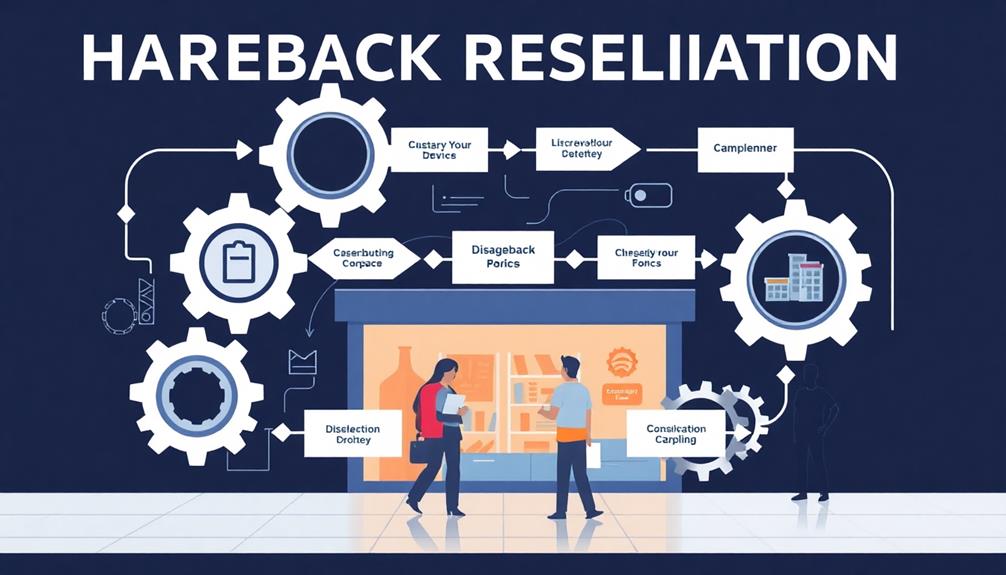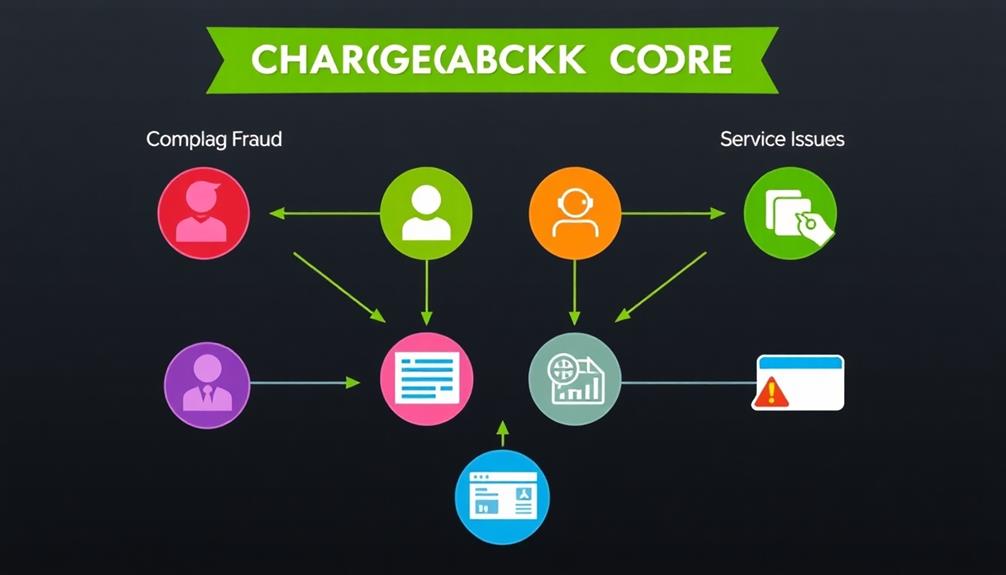To build a chargeback-resistant business model, start by establishing clear policies and procedures. Clearly outline your return and refund policies to reduce confusion among customers. Implement robust fraud detection tools to identify unauthorized transactions early. Maintain open communication with your customers, addressing their concerns before they escalate. Use detailed billing descriptors to prevent misunderstandings regarding charges. Regularly track chargeback metrics to refine your strategies and stay below the industry threshold. By focusing on these key areas, you'll create a stronger defense against chargebacks and enhance customer trust. There's even more you can do to cement this resistance effectively.
Key Takeaways
- Implement clear refund policies and detailed product descriptions to reduce customer misunderstandings and disputes.
- Utilize robust fraud detection tools and machine learning to identify and prevent unauthorized transactions.
- Maintain transparent communication about billing and delivery timelines to enhance customer trust and satisfaction.
- Regularly track chargeback metrics and customer behavior to identify trends and adjust strategies accordingly.
- Invest in chargeback management software to automate responses and improve efficiency in handling disputes.
Understanding Chargebacks
When you run a business, understanding chargebacks is vital to protecting your bottom line. Chargebacks are transaction reversals initiated by customers who dispute a charge, often in attempts to safeguard against fraud. However, they can also be manipulated, leading to significant financial losses for you as a merchant.
Friendly fraud, where customers falsely dispute legitimate purchases, is a growing concern, costing retailers around $89 billion annually. To combat this, implementing effective fraud prevention tools such as real-time monitoring systems can help detect potential issues before they escalate.
To effectively manage chargebacks, you need to understand chargeback reason codes. These codes help you identify why customers dispute a charge and allow you to implement an effective chargeback management strategy. Common causes include dissatisfaction with products, delivery issues, and accidental double charges.
By analyzing these reasons, you can refine your fraud prevention strategy and improve customer satisfaction. Additionally, it's important to use clear billing descriptors to make sure customers recognize your charges. This clarity can help prevent chargebacks for services you provide.
Implementing these strategies will allow you to reduce chargebacks, protecting your revenue and promoting smoother transactions. Understanding chargebacks is your first step towards building a chargeback-resistant business.
Common Chargeback Triggers

Chargebacks frequently arise from a variety of triggers that can impact your business's financial health. Understanding these common causes is essential for reducing disputes and maintaining a sustainable operation.
For instance, implementing clear communication strategies around your products and services can greatly mitigate misunderstandings that lead to chargebacks. Here are some key triggers to be aware of:
- Fraudulent transactions: A notable portion of chargebacks comes from fraud, where customers falsely claim a transaction wasn't authorized.
- Non-delivery: When products aren't received, customers are likely to file chargeback claims, citing non-delivery.
- Misunderstandings: Lack of clarity around recurring charges can lead to subscription disputes, particularly if cancellation policies aren't communicated well.
- Friendly fraud: This occurs when a legitimate customer disputes a charge while keeping the product, costing retailers billions annually.
- Processing errors: Confusing merchant names on bank statements can lead to chargeback claims from customers who don't recognize the charge.
Additionally, being aware of common cold medications can help in offering supportive products that enhance customer satisfaction and reduce disputes.
Effective Prevention Strategies

To effectively prevent chargebacks, you need clear policies and procedures that guide customer interactions.
Implementing robust fraud detection tools can help you identify unauthorized transactions before they become a problem.
Additionally, utilizing effective email marketing strategies to communicate your policies can further enhance customer understanding and compliance.
Clear Policies and Procedures
Establishing clear policies and procedures can greatly reduce the risk of chargebacks in your business. By creating a structured framework, you set customer expectations and guide them through proper channels, minimizing confusion that could lead to disputes.
Additionally, maintaining high-quality content on your website can reinforce trust and credibility, which is essential for customer satisfaction and reducing chargebacks high-quality content boosts credibility.
Here are some effective strategies to take into account:
- Clear Refund Policies: Outline your refund procedures clearly to help customers understand their options.
- Detailed Product Descriptions: Provide thorough descriptions, including images and specifications, to prevent misunderstandings about purchases.
- Transparent Communication: Keep customers informed about delivery timelines and order statuses to avoid dissatisfaction and non-receipt claims.
- Thorough Billing Descriptors: Verify that your transactions are clearly labeled, so customers can easily recognize them on their statements, reducing recall-related disputes.
- Regularly Review Chargeback Data: Analyze trends and update your policies to adapt and improve your strategies for effective prevention.
Robust Fraud Detection Tools
Fraud prevention goes hand in hand with clear policies and procedures, as both are vital in safeguarding your business from chargebacks. Implementing robust fraud detection tools like Address Verification Service (AVS) and Card Verification Value (CVV) checks can considerably lower unauthorized transactions and chargeback rates.
These tools offer essential layers of security, helping you verify customer identities and transactions effectively. Additionally, leveraging AI enhances threat detection can further strengthen your defenses against potential fraud attempts.
Utilizing machine learning algorithms enables you to analyze customer behavior patterns, detecting anomalies that may indicate fraudulent activity. This proactive approach to fraud detection can help prevent chargebacks before they occur.
Furthermore, real-time transaction monitoring systems allow you to assess risk and flag suspicious activities immediately, enhancing your chargeback prevention strategy.
Incorporating advanced identity proofing solutions, such as Know Your Customer (KYC) protocols, guarantees legitimate customer verification, minimizing instances of chargeback fraud.
By investing in extensive fraud protection services, you can achieve an impressive return on investment; studies show a potential 2,285% ROI through effective chargeback management strategies.
With these tools and strategies in place, you'll be better equipped to protect your business and maintain healthy profit margins.
Dispute Process Overview

When a customer disputes a transaction, it initiates a chargeback process that can considerably impact your business. The first step involves the customer contacting their bank to file a chargeback request, which can lead to funds being reversed back to them.
As a merchant, you typically have 30 to 45 days to respond to the chargeback notification with compelling evidence to contest the dispute. To effectively manage your online reputation during this time, consider strategies from top online reputation companies that specialize in crisis management.
To navigate the dispute process effectively, consider these key points:
- Understand the reason code associated with each chargeback.
- Gather compelling evidence that supports your position.
- Aim for successful representment to improve your win rate.
- Track and analyze chargeback data regularly.
- Implement strategies to reduce future occurrences.
Your merchant response is essential in this process. By recognizing the specific reason code, you can tailor your evidence accordingly.
Successful representment hinges on strong documentation and a well-thought-out strategy. Regularly reviewing chargeback data will help you identify trends and refine your dispute processes, ultimately fortifying your business against future chargebacks.
Metrics and Tracking Methods

To effectively combat chargebacks, you need to focus on key performance indicators that reveal how your business is performing.
Regularly analyzing your chargeback ratio helps you identify trends and make data-driven decisions for improvement.
By leveraging insights from your analytics tools, you can enhance your service delivery and reduce future disputes.
Implementing advanced technologies, like AI privacy enhancements, can also provide additional layers of security and customer trust, further minimizing chargeback risks.
Key Performance Indicators
In the world of chargeback management, understanding key performance indicators (KPIs) is vital for maintaining a resilient business model. By closely monitoring chargeback ratios and tracking total chargeback fees, you can identify trends and assess financial impacts effectively.
Ideally, you want to keep chargeback ratios below 1% of total sales to prevent chargebacks from harming your bottom line. To guarantee your business is well-prepared for financial changes, it's also essential to manage your cash flow strategically, as outlined in creating a retirement savings plan.
To enhance your monitoring program, consider these KPIs:
- Chargeback Ratios: Track the percentage of transactions that result in chargebacks.
- Total Chargeback Fees: Calculate the financial impact of chargebacks on your business.
- Dispute Resolution Success Rate: Measure the effectiveness of your responses to chargebacks.
- Customer Service Team Performance: Evaluate how well your team addresses customer concerns to prevent disputes.
- Fraud Prevention Tool Efficiency: Assess the success of tools designed to mitigate fraudulent transactions.
Regularly analyzing these metrics not only fosters accountability but also empowers your customer service team to implement chargeback protection strategies.
With detailed records, you can enhance your dispute resolution process and reduce chargebacks by up to 50%.
Chargeback Ratio Analysis
Analyzing chargeback ratios is essential for understanding your business's payment processing health. By dividing the total number of chargebacks by total transactions, you can gauge your chargeback ratio. Keeping this ratio below 1% helps you avoid penalties and protect your merchant accounts.
| Metric | Target Value | Action Needed |
|---|---|---|
| Chargeback Ratio | < 1% | Monitor and adjust strategies |
| Chargeback Fees | Minimized | Analyze financial impact |
| Chargeback Rates | Stable | Identify root causes |
Tracking chargeback fees and rates allows you to see the financial impact of transaction disputes. Regularly reviewing chargeback data helps uncover trends and root causes, enabling you to implement process improvements. This proactive approach helps prevent fraud and keeps your chargeback ratio in check.
Setting maximum thresholds for chargeback rates can trigger necessary actions before issues escalate. By focusing on these metrics and implementing targeted strategies, you can build a chargeback-resistant business model that safeguards your revenue and enhances your customer experience.
Data-Driven Insights
Effective chargeback management relies on robust data-driven insights that inform your strategies and decisions. By tracking key metrics, you can enhance your chargeback management approach and keep your business thriving.
Regularly monitoring chargeback rates is essential; aim to keep them below 1% of total sales. This not only helps maintain a healthy merchant account status but also prevents costly penalties from payment processors. Emphasizing actionable tips can further strengthen your strategies and minimize chargebacks.
Consider these vital data points:
- Analyze chargeback fees to improve financial planning; they can cost you an average of $3.75 for every $1 in chargebacks.
- Set maximum thresholds for chargeback rates to trigger necessary process improvements.
- Understand customer behavior and fraud trends through detailed analysis of chargeback data.
- Regularly report on chargeback metrics to foster accountability and strategic adjustments.
- Utilize insights to potentially reduce operational costs associated with chargebacks by up to 50%.
Financial Strategies for Protection

A solid financial strategy can be your best defense against chargebacks. Establishing financial reserves for potential chargebacks provides a safety net, protecting you from sudden revenue losses due to disputes.
Implementing a liability shift strategy allows you to transfer the financial responsibility for chargebacks from yourself to the card issuer, which mitigates risks tied to chargeback fraud. Additionally, enhancing customer interactions through personalized responses can build trust and loyalty, reducing the likelihood of disputes impact of NLP on customer experience.
Regularly analyzing chargeback fees and monitoring chargeback ratios enables you to make informed financial adjustments, setting thresholds for necessary process improvements. This proactive financial management helps you stay ahead of potential issues.
Investing in fraud detection tools, like advanced identity verification systems, can greatly reduce chargeback occurrences and result in an estimated 50% decrease in operational costs associated with chargebacks.
Additionally, utilizing chargeback alert services lets you identify potential disputes early, minimizing the impact on cash flow. By combining these financial strategies, you not only protect your business but also enhance your overall financial health.
Taking these steps can mean the difference between thriving in a competitive marketplace and struggling with ongoing financial challenges.
Utilizing Technology and Tools

To bolster your defenses against chargebacks, leveraging technology and tools can greatly enhance your strategy. By implementing advanced systems, you can greatly reduce the risk of disputes and streamline your operations.
Here are some essential technologies to take into account:
- Chargeback management software: Automate dispute responses, improving efficiency by up to 85%.
- Fraud detection systems: Use machine learning algorithms to identify fraudulent transactions early, combating over 60% of chargeback disputes related to cardholder fraud.
- Payment gateways with chargeback protection: Enable seamless transaction monitoring and reporting, enhancing dispute prevention.
- Identity proofing technologies: Verify customer identities during transactions, reducing the risk of unauthorized transactions and subsequent chargebacks.
- Data analytics tools: Analyze chargeback trends and patterns, guiding proactive strategies that can lead to a 50% reduction in operational costs associated with chargebacks.
Importance of Customer Communication

In today's fast-paced marketplace, clear communication with customers plays an essential role in minimizing chargebacks. When you provide recognizable billing descriptors and detailed transaction details, you reduce the likelihood of confusion or misrecognition of charges. This proactive approach can greatly decrease chargebacks that arise from misunderstandings.
Maintaining open lines of communication for inquiries and support is important. By resolving potential issues before they escalate into disputes, you can keep chargeback rates low. Proactive customer service—like timely updates on order status and delivery timelines—enhances customer satisfaction and minimizes misunderstandings that often lead to chargebacks.
Additionally, offering detailed product descriptions and transparent return/refund policies sets clear expectations for your customers. This clarity can decrease dissatisfaction-related chargebacks.
Educating customers about the chargeback process is also essential. Encouraging them to reach out for support before disputing charges not only mitigates unnecessary chargebacks but also fosters brand loyalty.
Frequently Asked Questions
How Do You Create a Chargeback Model?
To create a chargeback model, you need to analyze transaction data, implement transparent policies, utilize fraud detection tools, and maintain detailed documentation of interactions. Regularly review trends to refine your approach and prevent future disputes.
How Can Businesses Prevent Chargebacks?
You know, it's like teaching a cat to fetch—almost impossible! To prevent chargebacks, you've got to set clear policies, use identifiable billing, employ fraud detection tools, and communicate swiftly with customers to resolve issues.
Why Don't Companies Like Chargebacks?
You don't like chargebacks because they drain your profits and lead to extra fees. They also harm your reputation, risking your ability to accept credit cards. Managing them effectively is essential for your business's success.
What Are the Three Types of Chargebacks?
Imagine the storm of disputes swirling around you. The three types of chargebacks you'll encounter are fraud-related, product/service-related, and processing errors. Understanding them helps you navigate these turbulent waters and protect your business's integrity.
Conclusion
In the grand theater of business, chargebacks can play the villain, threatening your hard-earned profits. By understanding their triggers and employing effective prevention strategies, you can transform your operations into a fortress. Embrace technology, communicate with your customers, and track your metrics to stay one step ahead. Remember, a chargeback-resistant business isn't just a dream—it's a reality waiting for you to seize. With the right tools, you'll write your own success story, ensuring the spotlight stays on you.











